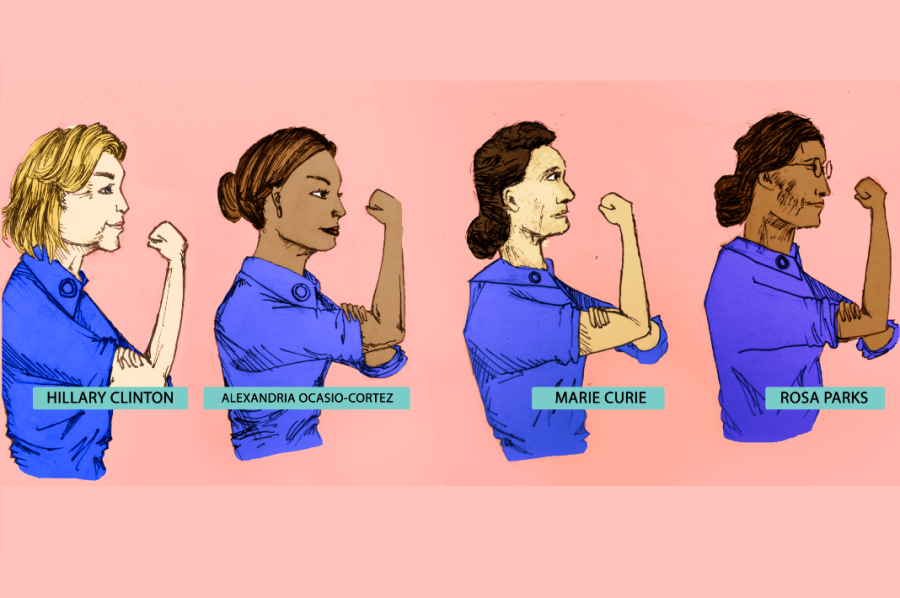We can do it: the rise of female leadership
May 3, 2019
What does it mean to be a woman? Google provides “member of the fair or gentle sex” as a synonym for “woman,” but simply “human being” for “man.” Yet, female leaders have proven time and again that they are more than just “fair or gentle.” They are game changers and trailblazers; they are innovators and scientists; they are inspirations and extraordinary human beings. The rise of female leadership has changed the landscape of politics, science and business around the world.
For most of human history, men and women’s roles in society have been distinct: men were the breadwinners, and women were the homemakers. While men were capable of building careers, women were seen as only fit for housework and childcare.
This divide first began to crumble when higher education first became available to wealthy women in the late 1800s. Then, during the Industrial Revolution, women began taking on jobs that were previously held by men only. The role of women in society shifted once more during World War II, when the shortage of civilian men forced employers to turn to employing women in factories and offices. Five million women entered the American workforce between 1940 and 1945, largely due to the number of soldiers leaving for duty.
Since then, women’s roles in the workforce have only grown. In the fields of social justice, politics, literature and science, women have been at the forefront of great movements and discoveries. Though it is impossible to name every influential woman in history, some well-known female pioneers are Florence Nightingale, the founder of modern nursing; Marie Curie, who discovered radium; Rosa Parks, a civil rights leader; and Ruth Bader Ginsburg, a U.S. Supreme Court justice.
These trailblazers paved the way and inspired today’s women to assume leadership positions themselves. Today, twenty-five women serve as heads of state around the world, and 48 were featured in TIME Magazine’s TIME 100, a list of the top 100 most influential people of the year. Following the examples set by the powerful women of previous generations, the modern woman has the social mobility to pursue a variety of careers.
“I definitely feel that my generation has greater gender equality compared to our parents’ generation,” said freshman Michelle Zhu. “Because of the women who came before us, it’s not as much of a struggle.”
Female leaders have, more than ever, been making their way into the limelight as of late. One notable example of this shift in the prominence of women in high-power positions came in the 2018 midterm elections, when voters elected one of the most diverse groups of Congress members in history. Forty percent of the 100 non-incumbents were female, compared to 24 percent of all current Congress members. Among the newcomers were Alexandria Ocasio-Cortez, the youngest Congresswoman in history; Ilhan Omar and Rashida Talib, the first Muslim Congresswomen; and Sharice Davids and Debra Haaland, the first Native American Congresswomen.
“Women are more than ever participating actively in various roles in society from participating more actively in politics, business and science,” said Priya Balasubramaniam, Vice President of iPhone Operations at Apple. “From flying planes, founding businesses and winning the Nobel Prize women today have greater opportunities to realize their potential than ever before.”
Women have recently been making waves in other fields as well, including STEM (Science, Technology, Engineering and Mathematics). For instance, Katie Bouman, a postdoctoral fellow at the Massachusetts Institute of Technology, developed a crucial algorithm used to obtain the first image of a black hole, which was released on April 10. Bouman and female STEM leaders like her prove that, contrary to old beliefs, women are as capable of innovation and leadership as men are.
“A girl who grows up without any women to look up to might not know what they’re capable of,” said Kavya Balaji, Vice President of Written Events of FBLA. “[Girls] would be at such a disadvantage not having that community of people to inspire [them] and show [them] what can be done.”
Despite the trailblazing work of these prominent female leaders, gender disparity still exists. A 2015 study of women in STEM identified four aspects of female workplace experiences that contribute to the lack of female leadership: the need for a woman to prove herself repeatedly in order to be taken seriously, the double standards applied to female behavior, the idea that working mothers cannot commit fully to their careers and the conflicts among women that arise as a result of these tensions. As a result, 2017 Pew Research Center study found that four in ten employed women claim they have been subject to gender discrimination in the workplace.
“I realize that there is [gender] bias, but I don’t make such a big deal out of it because it’s been such a part of my life so that I’m like, ‘Oh, it just happens,’” sophomore and Women Interconnecting Business founder Cheryl Lin said.
Empowering women means making use of a worthy half of the population which society has relied on from the Industrial Revolution. This inclusivity provides young girls with a group of role models to look up to and enforces the mentality for young boys that girls and boys are equally as capable, creating a positive stepping stone down the line for future generations of female leaders and innovators.





























































